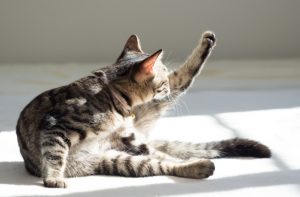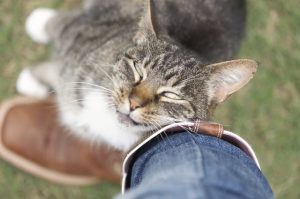
Cats are not as expressive of their happiness as dogs.
Indicators Showing the Level of Happiness of My Cat, signs and care
Appearance
Cats that are in good physical health will fastidiously groom themselves. Cats that are ill, feel uncomfortable, will not groom themselves and will appear unkempt. A well-groomed appearance is, therefore, a good indicator of feline happiness and contentment. Healthy, happy cats have clear, bright eyes, cool moist noses, and their coats are shiny and clean.
Happy cats have a clean, well-groomed appearance.
Body Language
Happy cats will have a relaxed body language. When resting, they usually have their legs tucked under their bodies. Their fur is smooth and resting against the body. Ears and whiskers are directed forward and their eyes are half-closed. When you engage them in eye contact, they will blink slowly. Some say that slow blinking is a cat’s way to say “I love you”.
From RSPCA, a visual guide to the body language of happy cats.
Social Interactions
Happy cats exude confidence and are well-adjusted with the humans and other pets in the household. They react to new people and pets with curiosity and caution instead of aggression. They like rubbing on people or even other pets to scent mark them.
Happy cats are confident, curious and like interacting with others.
Other Behavioural Cues
Good appetite is an indicator of a happy and healthy cat. Observe, however, for overeating because this may mean boredom, stress and unhappiness. The triggers of overeating must be identified and addressed before the cat develops obesity and the multitude of other health problems that come with it. Playfulness also signifies if my cat is a happy cat. This is because cats only play when all other basic physical have been met and they have the luxury of engaging in play. Happy cats are alert to their surroundings, have a regular sleeping habit, and use the litter box properly. Any changes in level of activity and alertness, sleep pattern or development of inappropriate elimination behaviour may indicate stress or illness that the cat owner must address immediately. Some cats are less social and communicative than others but it does not mean that they are unhappy. Each pet parent must be familiar with what is normal behaviour for their pet so that immediately can recognise any deviation from this.
Some cats have a naturally grumpy expression but that does not mean that they are unhappy.
Purring shows is my cat happy or not?
Some cat lovers think that “purring is the cat’s smile”. Purring is a sound developing as a way newborn kittens communicate with their mother when they are nursing. In general, a purr is a sign that the cat is happy and contented. While it is true that most cats are making happy purr, sick cats or in pain or feeling frightened also purr. Purring is believed to be is a self-soothing, self-healing mechanism cats use to reassure self and may have therapeutic value to them. Kneading, along with purring, is a behavior from the nursing period of kittens that they carry over to adulthood. It is also generally appears as a sign of happiness and contentment.
Kneading or “making biscuits” is generally a sign of contentment and happiness.
